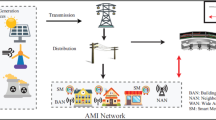Abstract
AMI is the core infrastructure of a smart grid and it is expected to be used for many industrial fields. The components of AMI generally include a smart meter, DCU, and MDMS. In such a system, the smart meter measures power consumption and DCU collects information from smart meters and send their data to MDMS. The MDMS is an end server to get information of the power usage and store its log and data. Since there are a lot of devices such as smart meters and DCUs in AMI, it is important to maintain the suitable number of them. In particular, it is necessary to calculate the proper number of DCUs for efficient management of AMI. In this paper, we suggest a way to predict the proper number of DCUs and this proposed method is useful to predict the total performance of heterogeneous AMI. The simulation results show that AMI is greatly influenced by the difference of performance between DCUs in the heterogeneous AMI.






Similar content being viewed by others
References
Aikebaier, A., Enokido, T., & Takizawa, M. (2011). Trustworthy group making algorithm in distributed systems. In HCIS 2011 (Vol. 1, p. 6).
Poh Ai Ling, A., & Masao, M. (2011). Selection of model in developing information security criteria for smart grid security system. Journal of Convergence, 2(1), 39–46.
Bennett, C., & Wicker, S. B. (2010). Decreased time delay and security enhancement recommendations for AMI smart meter networks. In Conference on innovative smart grid technologies (ISGT) (pp. 1–6).
Li, F. (2007). Continuous locational marginal pricing (CLMP). IEEE Transactions on Power Systems, 22(4), 1638–1646.
Li, F., & Bo, R. (2009). Congestion and price prediction under load variation. IEEE Transactions on Power Systems, 24(2), 911–922.
Li, F., Qiao, W., Sun, H., Wan, H., Wang, J., Xia, Y., Xu, Z., & Zhang, P. (2010). Smart transmission grid: vision and framework. IEEE Transactions on Smart Grid, 1(2), 167–177.
Bumiller, G., Lampe, L., & Hrasnica, H. (2010). Power line communications for large-scale control and automation systems. IEEE Communications Magazine, 48(4), 106–113.
Gungor, V. C., Sahin, D., Kocak, T., Ergut, S., Buccella, C., Cecati, C., & Hancke, G. P. (2011). Smart grid technologies: communication technologies and standards. IEEE Transactions on Smart Grid, 7(4), 529–539.
Luss, H., Neidhardt, A. L., & Krishan, K. R. (2009). An adaptive automated method for identity verification with performance guarantees. Electronic Commerce Research, 9(8), 225–242.
Roozbehani, M., Dahleh, M., & Mitter, S. (2010). Dynamic pricing and stabilization of supply and demand in modern electric power grids. In Conference on smart grid communications (SmartGridComm) (pp. 543–548).
McDaniel, P., & Smith, S. W. (2009). Security and privacy challenges in the smart grid. IEEE Security & Privacy, 7(3), 75–77.
Hsu, P.-H., Tang, W., Tsai, C., & Cheng, B.-C. (2011). Two-layer security scheme for AMI system. Journal of Convergence, 2(1), 47–52.
Paudyal, S., Canizares, C., & Bhattacharya, K. (2011). Optimal operation of distribution feeders in smart grids. IEEE Transactions on Smart Grid, 58(11), 4495–4503.
Silas, S., Ezra, K., & Blessing Rajsingh, E. (2012). A novel fault tolerant service selection framework for pervasive computing. In HCIS 2012 (Vol. 2, p. 5).
Misra, S. K., & Wickamasinghe, N. (2004). Security of a mobile transaction: a trust model. Electronic Commerce Research, 4(4), 359–372.
Loureiro, S., Molva, R., & Pannetrat, A. (2001). Secure data collection with updates. Electronic Commerce Research, 1(1), 119–130.
Yeo, S., & Lee, H.-H. S. (2011). Using mathematical modeling in provisioning a heterogeneous cloud computing environment. Computer, 44(8), 52–62.
Röhrig, S., & Knorr, K. (2004). Security analysis of electronic business processes. Electronic Commerce Research, 4(1), 59–81.
Gungor, V. C., Lu, B., & Hancke, G. P. (2010). Opportunities and challenges of wireless sensor networks in smart grid. IEEE Transactions on Smart Grid, 57(10), 3557–3564.
Author information
Authors and Affiliations
Corresponding author
Rights and permissions
About this article
Cite this article
Jung, SM., Kim, TK., Seo, HS. et al. The prediction of network efficiency in the smart grid. Electron Commer Res 13, 347–356 (2013). https://doi.org/10.1007/s10660-013-9124-1
Published:
Issue Date:
DOI: https://doi.org/10.1007/s10660-013-9124-1




